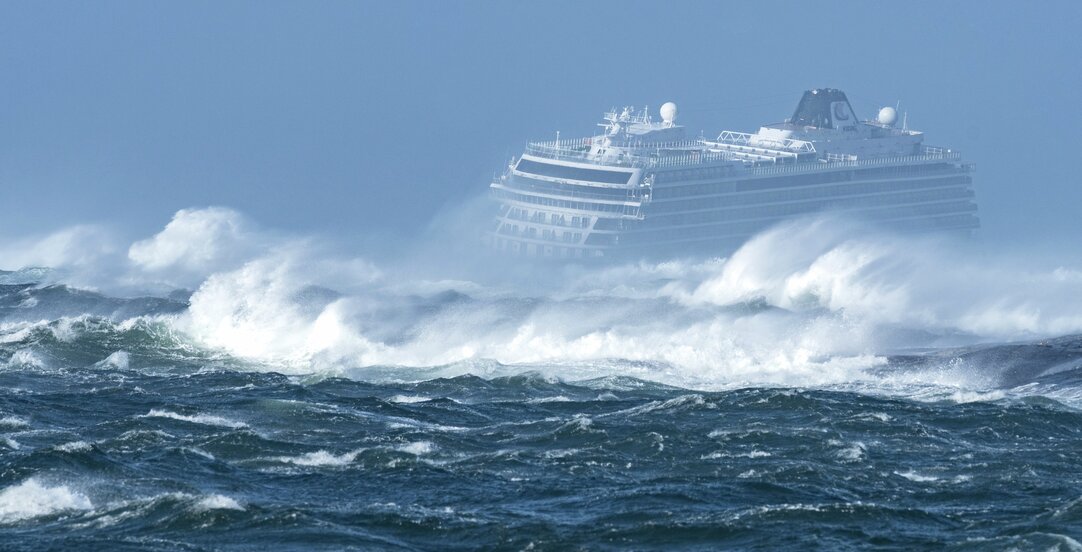Report on the safety of cruise traffic in Norwegian waters

In the spring of 2019, the cruise vessel “Viking Sky” suffered engine failure and almost grounded. Nearly three years later, a Norwegian Official Report (NOU 2022: 1) on how to reduce the risk of casualties within the cruise sector has been published.
Reading time 4 minutes
Although the cruise industry brings considerable benefits to Norwegian society and businesses, it also gives cause for safety concerns. The cruise industry is highly competitive, with several prominent actors operating globally, and the cruise ships calling at Norwegian ports keep getting larger every year. In 2019, approximately 26% of the global cruise vessel fleet made at least one voyage to Norway.
The substantial risks relating to the cruise industry were exemplified by the “Viking Sky” incident, which was handled by Wikborg Rein’s Emergency Response Team. The vessel, carrying around 1400 passengers and crew, suffered engine failure in rough seas off the west coast of Norway. Facing onshore wind and high waves, the vessel came precariously close to grounding. Several hundred passengers were evacuated by helicopters in one of the largest ever rescue operations, with a number of hospitalisations following the incident.
Identifying the main safety issues related to cruise traffic
The “Viking Sky” incident generated widespread media attention, instigating a debate about the risks within the cruise industry. Shortly after the incident, the government decided to commission a Norwegian Official Report, involving various stakeholders identifying the main safety issues relating to cruise traffic and recommending mitigating measures.
The Cruise Committee, which is the colloquial reference to the committee involved in preparing the Norwegian Official Report, presented its 66 recommendations on 23 February 2022. As a starting point, and from a practical point of view, it was considered impossible to scale the public emergency response system so that it could readily handle a casualty involving thousands of passengers. The report therefore focused on how to reduce the risk of these major accidents in the first place.
Although the Cruise Committee did not rank its recommendations, it noted that measures which reduce the probability of accidents were the most cost-efficient, and that such measures should accommodate the entire industry. Moreover, the Cruise Committee aimed to balance safety concerns with the cruise industry’s need for stable and viable operating conditions.
Some of the key proposals contained within the Norwegian Official Report are commented on below.
Both high-level and specific proposals
Several "high level" proposals were put forward, including establishing formalised cooperation between relevant public authorities and the cruise industry. The Norwegian government was also urged to draw up a holistic national plan for the entire industry, including an assessment of whether the Norwegian public authorities are appropriately organised to handle maritime casualties involving cruise vessels.
Various concrete measures were also suggested. One of the most restrictive proposals was that cruise vessels over 150 metres in length could become subject to sailing restrictions during certain time periods, weather conditions or in certain waters.
International regulations
The Cruise Committee also recommended that Norway should take a leading role in improving international safety regulations in the industry, including within the International Maritime Organization.
The Cruise Committee considered that this could be achieved by advocating the requirement of specific improvements for all larger passenger vessels, including as regards propulsion systems. It was also suggested that the Norwegian government could consider providing incentives to shipowners that utilised vessels with improved propulsion systems.
Other proposals included that all cruise ships should be required to carry towing equipment, that the functions and targets of rescue operations should be covered by the International Convention for the Safety of Life at Sea (SOLAS), that the preliminary guidelines in the Polar Code regarding rescue equipment should be made mandatory, and that an international standard for calculating the maximum expected rescue time should be established.
Information and communication
The Cruise Committee made several recommendations relating to access to information and communication, such as a proposals to provide daily ice maps and improve navigational charts. Many of these proposals were directed at public authorities.
Various proposals were also aimed at making the information and communication processes more efficient. The relevant public authorities were urged to prioritise automation of monitoring and reporting processes, and it was recommended that all official information relevant to the cruise industry be published on one platform. It was also suggested that technological solutions for passenger and evacuee lists be considered.
Moreover, the Cruise Committee recommended placing more onerous requirements on shipowners. For instance, it was suggested that cruise vessels immediately report changes which could influence the vessels’ operative ability or automatic positioning reporting. Removing the remaining limited exemptions to the requirement that all passenger vessels are required to have functioning AIS onboard was also suggested.
Svalbard and the Arctic
There were several proposals relating to Svalbard and the Arctic, such as a proposal requiring bridge and engine crew to undergo basic training based on the Polar Code. A majority of the Cruise Committee also proposed that cruise vessels sailing within Svalbard’s territorial waters should not be allowed to carry more than around 500–750 people, however, a minority of the Committee dissented on this question.
Assessment and reflections
The 164 page report was handed over to the Norwegian Minister of Justice and Public Security, who sent the report on public hearing with a deadline on 15 September 2022 for submitting comments. Whilst implementation will come at a cost to stakeholders, several of the Cruise Committee’s proposals appear well suited to reducing the risk of significant casualties and loss of life in the future. Industry players would therefore be well advised to keep an eye out for regulatory changes.

